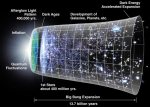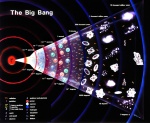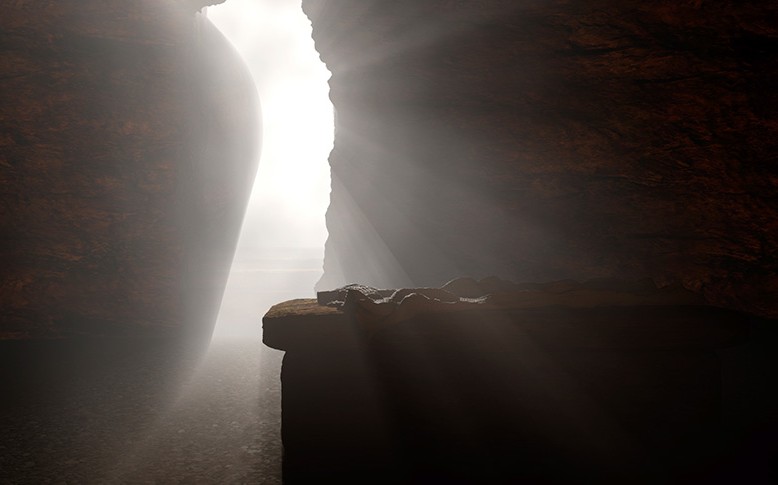 Many philosophical and apologetic arguments are difficult to commit to memory. Some arguments consist of five thorough points. Sometimes these arguments are difficult to bring out especially when you are speaking to someone about the faith. However, there is one such argument that is short enough that it is easy to remember, sweet enough to get people thinking, and stout enough to hold up even to the most ardent objector. This argument is called the Kalaam Cosmological Argument. It was originally developed by a Muslim in the late 11th century by the name of Abu Hamid Muhammed ibn Muhammed al-Ghazali. He is known by his shortened name Al-Ghazali. In recent days, the Kalaam Cosmological Argument has been revived and brought to the public sphere by Christian apologist William Lane Craig. Craig has written extensively on this argument and one of his resources will be used in this article. The argument consists of three premises:
Many philosophical and apologetic arguments are difficult to commit to memory. Some arguments consist of five thorough points. Sometimes these arguments are difficult to bring out especially when you are speaking to someone about the faith. However, there is one such argument that is short enough that it is easy to remember, sweet enough to get people thinking, and stout enough to hold up even to the most ardent objector. This argument is called the Kalaam Cosmological Argument. It was originally developed by a Muslim in the late 11th century by the name of Abu Hamid Muhammed ibn Muhammed al-Ghazali. He is known by his shortened name Al-Ghazali. In recent days, the Kalaam Cosmological Argument has been revived and brought to the public sphere by Christian apologist William Lane Craig. Craig has written extensively on this argument and one of his resources will be used in this article. The argument consists of three premises:
1) Everything that begins to exist has a cause.
2) The universe began to exist.
3) Therefore, the universe has a cause.
For this article, we will examine the three premises in greater detail. For exhaustive treatment of this argument, see the resources used at the end of this article. Let us now examine the first premise.
1. Everything that begins to exist has a cause.
The first premise of the argument is logically sound. Everything that begins to exist has a purpose for its existence. For instance, your existence is the result of your biological parents consummation. Now, because you exist, it could logically be demanded that a host male and female parent had to exist. Your existence demands their existence. Your existence did not come by way of happenstance. There was a reason for you to be here. (The naysayer may claim that instances of rape and incestual relationships counter this claim. However, your existence is still a good thing. Therefore, even though a person’s consummation may have come from less than favorable circumstances, good came through even the most horrible of circumstances…ie. the child’s existence. Let us pick up that argument in a later article and continue on with the subject at hand.)
The cause-effect relationship is the fundamental building block of science itself. When I worked as a teaching assistant, I helped instruct the children on the fundamentals of science. The first step is understanding the causal relationship. So, this causal relationship is fundamental in all things. When a crime scene investigator examines a corpse, he/she wants to know the cause of this person’s death. Was it a homicide? Was it a suicide? Or, was it by natural causes? Craig writes, “Premise (1) seems obviously true-at the least, more so than its negation. First and foremost, it’s rooted in the metaphysical intuition that something cannot come into being from nothing. To suggest that things could pop into being uncaused out of nothing is to quit doing serious metaphysics and to resort to magic. Second, if things really could come into being uncaused out of nothing, then it becomes inexplicable why just anything and everything do not come into existence uncaused from nothing. Finally, the first premise is constantly confirmed in our experience. Atheists who are scientific naturalists thus have the strongest of motivations to accept it” (Craig 2008, 111-112).
When we think of cosmological arguments for the existence of God, particularly the Kalaam Cosmological Argument, it is the same with the universe. Because we are here, because there is design in the universe, and because there is something rather than nothing (we are not speaking of Krauss’ logically absurd “nothing something” here), we are forced with a first causing agent: God. This is the first premise. Let us now look at the second premise.
2. The universe began to exist.
The second premise of the argument is one that has been confirmed by scientific data. The belief that God created the universe ex nihilo (from nothing) is a biblical concept, as well. Let us consider four reasons why the Christian can and should accept the fact that the universe began to exist.
Big Bang Theory
Oh no! Doesn’t the “Big Bang Theory” conflict with Genesis 1? Actually…no, it doesn’t. We will examine the biblical references showing that God created the universe “ex nihilo” later. For now, it must be accepted as a fact that the universe is not eternal, but finite. The Big Bang Theory shows just that. Craig explains, “The standard Big Bang model, as the Friedman-Lemaitre model came to be called, thus describes a universe which is not eternal in the past, but which came into being a finite time ago. Moreover–and this deserves underscoring–the origin it posits is an absolute origin out of nothing. For not only all matter and energy, but space and time themselves come into being at the initial cosmological singularity” (Craig 2008, 127). How do the scientists know that a Big Bang occurred? Well, it has to do with the expansion of the universe. The universe as we know it is running out of energy. It is expanding at a faster rate and will eventually cool and lose the energy contained within. This corresponds with the 2nd Law of Thermodynamics which we will cover in a moment. Because the universe is expanding, this forces one to concede the fact that if you were to travel back in time, you would find the universe becoming more and more dense and smaller. Turek and Geisler give five reasons why one can know that the universe had a beginning. They give a handy acronymn “SURGE” to remember the five points. “S=Second Law of Thermodynamics…U=Universal Expansion…R=Radiation Afterglow…G=Galaxy Seeds…E=Einstein’s Theory of General Relativity” (Geisler and Turek 2004, 76-83). If you want to learn more about these five points, pick up Norman Geisler and Frank Turek’s book I Don’t Have Enough Faith to be an Atheist. We will examine one of the five points.
2nd Law of Thermodynamics
Geisler and Turek explain this law, “Thermodynamics is the study of matter and energy, and the Second Law of Thermodynamics states, among other things, that the universe is running out of usable energy. With each passing moment, the amount of usable energy in the universe grows smaller, leading scientists to the obvious conclusion that one day all of the energy will be gone and the universe will die. Like a running car, the universe will ultimately run out of gas” (Geisler and Turek 2004, 76). If you do not believe in the 2nd Law of Thermodynamics, just look at a picture of yourself taken 10 years ago and then look at yourself in a mirror now. You have aged. As time progresses, your body will begin to break and wear down eventually leading to death (or the beginning of an exciting new life for the Christian). This is an example of the 2nd Law of Thermodynamics in action. Because the universe is running out of energy, there must have been a starting point where the universe was given all the energy contained within itself. This starting point is even more remarkable when one understands that there was no universe, no time, and no energy in the universe before the universe began. This demands that the universe, the energy contained within, and the laws of nature governing it came from an outside source…a source that contains more power than the sum total of power contained within the universe…is timeless…and able to provide the design and governing laws contained within the universe. I don’t know about you, but that sounds a lot like God to me!!!
Villenkin/Guth/Borg Mathematical Theorem
Some naturalists have tried to wriggle around the obvious conclusions which a finite universe brings by claiming that this universe came from a larger unmanned universe. They call this mother universe to all universes a “multiverse.” This theory is also called the “M-Theory.” There are inherent problems with this theory. For one, there is not conclusive evidence that there is a multiverse. A multiverse would, if it exists, not be able to be observed now, if ever. Therefore, the adherents of such a view would have to accept a multiverse’s existence on faith. However, what many do not realize is that a multiverse solves nothing. A multiverse only pushes the problem back a step. Robert J. Spitzer, former president of Gonzaga University, wrote about three mathematicans who discovered a fascinating mathematical theorem (a theorem in mathematics is like a law in physics). Spitzer writes, “This stronger proof, put forward in 2003 by Arvind Borde, Alan Guth, and Alexander Vilenkin (henceforth BGV), considers space-times satisfying the condition that the average Hubble expansion in the past is greater than zero, i.e., H(av) > 0…In other words, the BGV result demonstrates that all inflationary space-times have a beginning in the finite past, presumably in some sort of quantum nucleation event that mitigates the breakdown of physics accompanying a classical singularity…By the impeccable logic of the kalam argument, the BGV theorem implies that space-times expanding on average throughout their histories are caused – they are caused because they began to exist, and everything that begins to exist requires a cause. Furthermore, this cause must be transcendent in nature because space-time cannot be self-caused: prior to the existence of all space, time, matter, and energy there was no universe to describe and there were no physical laws or initial conditions that could have played a role in its genesis; rather, all these things came into existence out of nothing, so a transcendent immaterial cause must necessarily have acted” (Spitzer 2010, 76-77). In other words: even if a multiverse existed, the multiverse would have come into being at a finite point in time. Therefore, the naturalist has not escaped the “God dilemma.” The naturalist has only pushed the problem back a step.
Biblical References to Creation “Ex Nihilo”
Numerous references could be given at this point. We will however limit the references to five passages which indicate that God created the universe from nothing.
Genesis 1:1
“In the beginning God created the heavens and the earth.”
Psalm 33:6
“By the word of the LORD the heavens were made, And by the breath of His mouth all their host.”
John 1:3
“All things came into being through Him, and apart from Him nothing came into being that has come into being.”
Romans 4:17
“(as it is written, “A FATHER OF MANY NATIONS HAVE I MADE YOU”) in the presence of Him whom he believed, even God, who gives life to the dead and calls into being that which does not exist.”
Hebrews 11:3
“By faith we understand that the worlds were prepared by the word of God, so that what is seen was not made out of things which are visible.”
So you see, the Bible strongly indicates that the Eternally Conscious, Living, God brought the universe into existence from no material, but established everything by God’s command. Now, let us examine the final premise to the Kalaam Cosmological Argument.
3. Therefore, the universe has a cause.
Since the first two premises hold, the final premise is a given. The universe had a cause. There are two primary reasons to hold that the universe has a cause.
First Cause
What we have learned is that before the singularity (the point where everything in the universe could fit inside a sewer’s pin), nothing physical in the universe (energy, laws of physics, or matter) existed. Something had to cause the universe’s existence because we are here now experiencing the universe. Thomas Aquinas wrote, “Now in efficient causes it is not possible to go on to infinity, because in all efficient causes following in order, the first is the cause of the intermediate cause, and the intermediate is the cause of the ultimate cause, whether the intermediate cause be several, or one only. Now to take away the cause is to take away the effect. Therefore, if there be not first cause among efficient causes, there will be no ultimate, nor any intermediate cause. But if in efficient causes it is possible to go on to infinity, there will be no first efficient cause, neither will there be an ultimate effect, nor any intermediate efficient causes; all of which is plainly false. Therefore it is necessary to admit a first efficient cause, to which everyone gives the name of God” (Aquinas, I.2.3., 1990, 66-67). In other words, if one had three dominoes, the person (first cause) would push down the first domino which would push down the second domino (intermediate causes) which would finally push down the last domino (ultimate cause). Or another way to look at it would be like the classic game Mouse Trap. The player initiates a series of events which eventually leads to the ultimate cause (catching the mouse with a plastic net). The player and initial domino pusher were the first causes. Likewise, God is the necessary first cause to the universe.
Design
There is no doubt that the universe has greatly been designed. Spitner gives seven lines of evidence concerning the design of the universe. “(1) The first instance is given by Roger Penrose, who shows the exceedingly high improbability of a low-entropy condition (which is compatible with the Second Law of Thermodynamics and essential for our anthropic universe) arising out of the big bang…The odds of our anthropic universe arising amidst the total phase-space volume of possible universes for a creation event is so exceedingly, exceedingly, exceedingly remote that it’s notation in regular exponential form is one part in: 10(1000000000000000000000000000000000000000000000000000000000000000000000000000000000000000000000000000000000000000000000000000) (my note: there are 123 zeroes in case you lost count)…
(2) The second instance concerns the interrelationship among the gravitational constant (G), weak force constang (gw), and the cosmological constant (Λ) with respect to the rate of acceleration (and possible collapse) of the universe as a whole…
(3) A third instance of improbable anthropic conditions concerns the strong force constant (especially in its relationship to the electromagnetic constant). This constant cannot vary more or less than 2 percent from its current value (gs=15) without rendering impossible the formation of either hydrogen or any other element heavier than hydrogen…
(4) A fourth instance of the improbability of anthropic conditions in our universe concerns the relationship between the gravitational and weak force constants on the one hand, and the neutron-proton mass and electron mass on the other…
(5) A fifth instance of the improbability of anthropic conditions concerns the gravitational constant in its relation to the electromagnetic constant and the ratio of electron to proton mass…
(6) A sixth instance of the improbability of anthropic conditions concerns the weak force constant and its relationship to the carbon atom…
(7) A seventh instance can be adduced from the resonances of atomic nuclei” (Spitzner 2010, 57-64). These are only seven among over 180 constants of design that have been found in the universe. There seems to be a going trend. That trend indicates that we are here for a cause. The Causer is God.
Conclusion
The cosmological argument is among one of the strongest arguments for the existence of God. The other contender would be the teleological argument (evidence from design). These arguments were strong enough to persuade longtime atheist Antony Flew of God’s existence. Flew accepted the existence of God a few years before his death. It is not known if he ever came to be a Christian, however. Among the cosmological arguments, the Kalaam Cosmological Argument stands strong. The Kalaam Cosmological Argument is logically sound, biblically sound, and scientifically sound. Also, the Kalaam Cosmological Argument is short enough to remember, sweet enough to get people thinking, and stout enough to hold through the toughest critic’s objections. The Kalaam Cosmological Argument is one argument that the Christian defender should learn well.
Bibliography
All scripture, unless otherwise noted, comes from New American Standard Bible: 1995 Update. LaHabra, CA: The Lockman Foundation, 1995.
Aquinas, Thomas. Summa Theologicae. Fathers of the English Dominican Province, trans. Summa of the Summa, Peter Kreeft, ed. San Francisco, CA: Ignatius Press, 1990.
Craig, William Lane. Reasonable Faith: Christian Truth and Apologetics, 3rd ed. Wheaton, IL: Crossway Books, 2008.
Geisler, Norman and Frank Turek. I Don’t Have Enough Faith to be an Atheist. Wheaton, IL: Crossway Books, 2004.
Spitzner, Robert J. New Proofs for the Existence of God: Contributions of Contemporary Physics and Philosophy. Cambridge, UK: William B. Eerdmans Publishing Company, 2010.









Thanks so much for sharing this excellent info! I’m seeking forward to see much more posts! kdaegddbeedg
[…] http://pastorbrianchilton.wordpress.com/2013/09/27/the-kalaam-cosmological-argument-short-sweet-and-… […]
[…] The Kalaam Cosmological Argument: Short, Sweet, and Stout. […]
Thanks so much for sharing this excellent info! I’m seeking forward to see much more posts! kdaegddbeedg
[…] http://pastorbrianchilton.wordpress.com/2013/09/27/the-kalaam-cosmological-argument-short-sweet-and-… […]
[…] The Kalaam Cosmological Argument: Short, Sweet, and Stout. […]